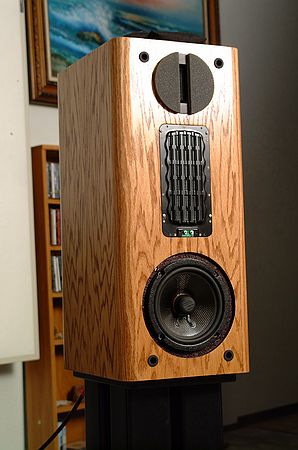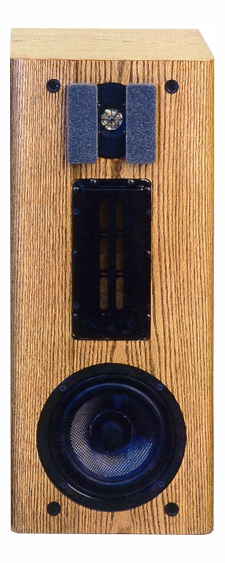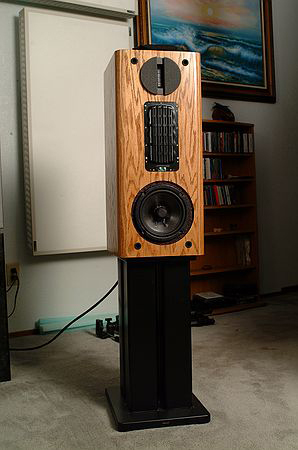You are reading the older HTML site
Positive Feedback ISSUE
15
september/october 2004
vmps
Signature Edition 626R ribbon loudspeakers
as reviewed by John Beavers

|
JOHN BEAVER'S SYSTEM
LOUDSPEAKERS
ELECTRONICS
SOURCES
CABLES
ACCESSORIES
|
My first listening experience with the VMPS 626R ribbon monitors was at Brian Cheney’s audition room in El Sobrante, California. With my long history of owning dynamic speakers, the 626Rs were quite an ear opener. What stood out on first listen was the quicker, more natural rhythm and pace of the music. I also experienced an increase in my listening involvement, with an excitement that had me reaching out for what I was hearing. The 6-1/2-inch bass drivers of the 626Rs were putting out some very potent low-frequency dynamics. The midrange ribbon panel rendered vocals in a neutral and full sounding manner. It was the high frequencies that really got my attention, though. I’d never heard such sparkle and transparency from a tweeter. The sound of cymbals and strings was crisp and stunningly vibrant. I was on a sonic thrill ride!
After my audition and a tour of the VMPS facility, I continued my speaker auditioning with a visit to a local high-end audio store. After explaining that I was looking for stand-mounted monitors, they said they had just what I needed in Joseph Audio. They spoke of all the awards these monitors had won. Perhaps if I had not just come from listening to the 626Rs, I would have fallen all over myself to purchase these speakers. They were very good—perhaps better in some respects than the Dynaudio monitors I've owned. Driven by a Conrad Johnson tube integrated amp, they produced a very wide soundstage. I was impressed on an analytical level, but was bored and uninvolved with what I was hearing, whereas at the 626R audition, I had turned to Brian after each song with a heartfelt "Wow!" I asked the salesman if they had any other speakers I could hear. He suggested the new reference monitors from Paradigm. After setting them up in the same system, it took only a few minutes of listening to realize that they were not what I was looking for.
The next leg of my journey had more promise. I was going to get a taste of the Quad 989 electrostats. The midrange immediately took center stage. I hadn’t heard vocals with this level of richness and presence before. I also felt that the Quads excelled at the high frequencies, though not to the extent of the 626Rs. Bass was decent, but not the strong point of the Quads. Their soundstage was fairly wide and deep, if I sat in the sweet spot. Unless I was in that spot, the soundstage dropped off, to be replaced by the mono sound of the speaker I was sitting closest to. In all, though, the combination of luxurious vocals and breathtaking transparency showed me why these speakers have such a following. I was tempted, but not fully sold. I would need to bring my wife for a final audition of these two contenders for my next set of speakers.
When my wife and I went to audition the Quads and the VMPSs, the most memorable moment of the 626R audition was when Brian Cheney went to the piano in his audition room. He matched the volume of the audio system to that of a note struck on his piano. The comparison between the real piano and the recorded one was too close to call. It was truly an "Is it live or is it Memorex?" experience. Another revealing moment was when my wife heard one of her least favorite of my recordings, a tenor sax number by Eddie "Lockjaw" Davis. After listening to the song, she turned to me and said, "That doesn't bother my ears like when you've played it on your system." Believe me, it's more than bother. If she's anywhere near the listening area, I cannot play music of that nature because of the distress it causes her. For her to sit through an entire tenor sax number, in a relaxed state, and then say it sounded good, was a minor miracle.
The reason for my search for new speakers was an issue I was having with my neighbor—my Dynaudio Contour S3.4 floorstanders were putting out bass that was disturbing him to no small degree. I needed to find speakers with reasonable bass, but not of the wall-shaking variety. At this point in the audition, I asked my wife whether she found the 626Rs acceptable in that department, and she responded that they could cause a problem at the volume levels we were using. Overhearing this, Brian turned the speakers down to less than 70dB. My wife watched me intently as he did this, to see if the enjoyment I had been experiencing drained from my face, as it does when I've had to turn down the volume with my Dynaudios. It turned out that the VMPSs were superb at low volumes, but the dealmaker for her—beyond the fact that she liked the sound—was the listening method that Brian showed us next. He said that if all else failed, we could always use the 626Rs as speakerphones. Huh? With a grin, he toed the speakers into a sharp "V" configuration, and asked me to slide my chair to the apex of the V, about three feet from the speakers. He turned on the volume and WOW! Speakerphones, dude! Not the center-of-the-head stuff I can't stand with headphones, but with imaging just as before and practically the same dynamics and tonal brilliance, even at the lower volume. At this level, anyone not within the nearfield listening zone would considered this background music.
 My wife and I came out of this
audition very impressed, and talking of things like cabinet finish, room
treatments, and getting a dedicated chair for nearfield listening, although she
still wanted to hear the Quads before giving her blessing to the 626Rs. After
doing so, she felt that the 989s were too big for our room, and she either hated
the sound or found it boring. On my part, I made a discovery about the 626Rs—any
speakers you hear afterwards, no matter how good you thought they sounded, will
sound unengaging and not quite "right." I was amazed. How could two listening
experiences with the Quads, within three days of each other, be so different?
The answer was that it had nothing to do with the Quads. It had to do with my
ears being exposed to speakers that do it right to a very great degree, then
hearing speakers that do many, but not all things right. The performance aspects
they lacked were brought out in stark relief.
My wife and I came out of this
audition very impressed, and talking of things like cabinet finish, room
treatments, and getting a dedicated chair for nearfield listening, although she
still wanted to hear the Quads before giving her blessing to the 626Rs. After
doing so, she felt that the 989s were too big for our room, and she either hated
the sound or found it boring. On my part, I made a discovery about the 626Rs—any
speakers you hear afterwards, no matter how good you thought they sounded, will
sound unengaging and not quite "right." I was amazed. How could two listening
experiences with the Quads, within three days of each other, be so different?
The answer was that it had nothing to do with the Quads. It had to do with my
ears being exposed to speakers that do it right to a very great degree, then
hearing speakers that do many, but not all things right. The performance aspects
they lacked were brought out in stark relief.
I ordered my 626Rs the next day. They would have light oak cabinets, along with the upgrade options of FST tweeters, TRT caps, and soundcoat. A few weeks later, my speakers were ready to pick up. VMPS speakers are true tweako audio enthusiast products. You can tailor their sound to your taste and room acoustics. On the 626Rs, you have one tuning pot for the midrange panel and one for the ribbon tweeter. I found the optimal toe-in to be as the manufacturer recommends—two feet in front of the listening position. Everything is voiced to image wonderfully at that angle. The tuning pots sounded best at about noon on the midrange panels and 12:15 PM on the tweeters.
In my first listening session with the 626Rs at home, they came across as very detailed and dynamic driven by my Unico integrated amp and Audiomeca CD player. I forgot my concern that an 80wpc amp and monitor speakers would give me less dynamics than my Dynaudio floorstanders and powerful monoblock amps. The Unico with the VMPSs seemed just as potent as my 650wpc mono amps with the Dynaudios, though not in bass response, which in my situation is a good thing. Bass was present and accounted for, but it was not as deep and authoritative as with the Dynaudios.
Where the 626Rs completely pulled away from the Dynaudios was in the high frequencies and upper midrange. I have not heard a more true-to-life rendition of guitars, electric or acoustic, from any other speakers. With my Audiomeca Mephisto II.X spinning the discs, I was treated to some of the most extended, transparent, and sparkling highs I’ve had the pleasure to experience. I then switched to my Adcom DVD player to see how a more mid-fi product would sound with the 626Rs. The first concert DVD I played left me with the fear that they were not going to be effective with less than high-end source components. After another DVD concert sounded lifeless and clouded, I was about to consider going to a higher-quality DVD player or accepting that not all media were going to provide the magic.
Then I put in a third DVD concert, and all bets were swept off the table. Brian Setzer Orchestra: Live In Japan is one of my favorite DVDs. It is also a great test disc, as it will reveal whether your system leans to the harsh or bright. Expecting more lifeless sound, I hit play, and that was the end of any critical evaluations for the day. Live electric guitar has a texture and weight that is hard for recording engineers to get right. I assumed that I needed megabuck gear to bring it out, but it appears that all I needed was a well-recorded disc and the right speakers. I was enthralled by the live presence of this DVD. With my Simaudio/Dynaudio combo, it bordered on bright. With the 626Rs, it sounded relaxingly musical, yet harmonically rich and intense. After the first song, I found myself on my feet, doing some air guitar and stage dancing. That is when an audio component makes the grade with me. If I can sit through an evaluation period and come away with a list of positive and negative impressions, that component is probably not long for my rig. I want components that can overcome my analytical side, and get me so involved in the performance that I start having FUN.
Since those first weeks with my VMPS speakers, much has changed. My room is now acoustically treated, I upgraded from the Unico integrated to separates, and my 626Rs have undergone the Signature upgrade. The upgrade added a mega-woofer and Analysis Plus silver wiring, and replaced the cabinets with African ebony ones. The sonic changes were significant. The new woofer is much more robust, and it provides stronger bass impact and a more weighty rendering of the lower frequencies. The new cabinet is very inert, with thicker cabinet walls and internal cross bracing.
I’ve only had the Signature 626Rs for a week, and I’m still familiarizing myself with the changes. Last night I listened to a CD that included the sound of a large bass drum. It had all the sonic weight you would expect. It was strikingly etched within the soundstage. I could picture the drum more clearly than ever before, positioned in back of my right speaker and about halfway up the wall. I had holographic imaging before, but not nearly at this level. The image has also expanded in both width and depth.
True value in high-end audio can be difficult to find. I’ve owned more expensive speakers than the VMPS Signature Edition 626R monitors, but nothing has bettered them. To be able to upgrade drivers, internal parts, and cabinets is unique in my experience with high-end audio, and much appreciated. These speakers can evolve as technology improves. They are now my reference for top-quality sound in a monitor design. John Beavers

626R loudspeaker
Retail: $4150 pair (as reviewed)
Base model: $799
each
FST ribbon
tweeters: $200 each
Cabinet upgrade
(ebony, rosewood, diamond black lacquer): $200 each
TRT caps:
$1200/pair
Soundcoat:
$150/pair
Silver wire:
$400/pair
VMPS Audio Products
3429 Morningside Dr.
El Sobrante, CA 94803
TEL: 510. 222. 4276
email address: [email protected]
web address: www.vmpsaudio.com
